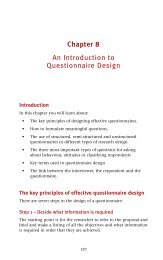The growing business handbook : inspiration and advice ... - Sparkler
The growing business handbook : inspiration and advice ... - Sparkler
The growing business handbook : inspiration and advice ... - Sparkler
You also want an ePaper? Increase the reach of your titles
YUMPU automatically turns print PDFs into web optimized ePapers that Google loves.
How to compete against fast-moving, innovative competitors<br />
13<br />
for monopolies continued to disappear. <strong>The</strong> result was accelerated commoditization,<br />
increasing price wars <strong>and</strong> shrinking profit margins.<br />
On the other h<strong>and</strong> Blue Ocean companies, like those in emerging markets,<br />
underst<strong>and</strong> how to identify <strong>and</strong> develop untapped markets, where dem<strong>and</strong> can be<br />
created <strong>and</strong> the opportunity exists for highly profitable growth. Most new Blue<br />
Ocean companies are created from within Red Ocean companies by exp<strong>and</strong>ing<br />
existing industry boundaries <strong>and</strong> are driven by competition-based Red strategists.<br />
<strong>The</strong>y open new <strong>and</strong> uncontested market space. <strong>The</strong>y underst<strong>and</strong> that creating Value<br />
without innovation tends to focus value creation on an incremental scale, something<br />
that (while it improves the value) is not sufficient to make the products <strong>and</strong> services<br />
st<strong>and</strong> out in a global marketplace. Innovation without value tends to be technology<br />
driven, market pioneering or futuristic, often shooting beyond what buyers are ready<br />
to accept <strong>and</strong> pay for.<br />
To be really successful innovation requires a ‘leap in value’ for both the buyers <strong>and</strong><br />
suppliers. Red Ocean companies believe that the structural constraints are given <strong>and</strong><br />
that firms are forced to compete within them (a structuralist view or environmental<br />
determinism). Instead Blue Ocean companies believe that market boundaries <strong>and</strong><br />
industry structures are not given <strong>and</strong> that they can be changed by the actions <strong>and</strong><br />
beliefs of the players.<br />
Are we exaggerating this corporate ability to be innovative <strong>and</strong> to develop<br />
untapped markets? Proof that it is possible can be seen from the new industries that<br />
emerged over the past 100 years, including automotive, sound <strong>and</strong> picture recording,<br />
petrochemical, health care, management consulting etc. When everyone thought<br />
there were no new markets to create, radical new ones were invented, eg mutual<br />
funds, mobile phones, gas-fired electricity plants, discount retailers, express package,<br />
snowboards, coffee bars, home videos etc. Is this rate of innovation slowing? Not if<br />
the emergence of new products such as Twitter, Facebook, iPhone, iPad etc are<br />
anything to go by.<br />
<strong>The</strong> future is in your company’s h<strong>and</strong>s; avoid fixating on analysing the past <strong>and</strong><br />
predicting the future otherwise your company will remain a Red Ocean company <strong>and</strong><br />
you will be left behind by emerging, nimble, intuitive Blue Ocean companies.<br />
Creating Blue Ocean strategies<br />
Kim <strong>and</strong> Mauborgne recommend that companies wishing to create Blue Ocean<br />
strategies underst<strong>and</strong> in detail how their products/services perform against the market<br />
in order to underst<strong>and</strong> what Value the ultimate customer derives from acquiring<br />
them. <strong>The</strong>y encourage companies to underst<strong>and</strong> what the trade-off is between<br />
differentiation <strong>and</strong> low costs in order to create new value curves. Ask what factors,<br />
which your industry takes for granted, could be eliminated, or could be reduced<br />
below the industry’s st<strong>and</strong>ard; what could be raised above the st<strong>and</strong>ard; <strong>and</strong> what<br />
factors could be created that the industry has never offered. <strong>The</strong>ir Eliminate-Reduce-<br />
Raise-Create Grid pushes companies to underst<strong>and</strong> the opportunities facing them<br />
<strong>and</strong> to develop innovative strategies to find their very own clear Blue Ocean Strategies.<br />
You can tell if your strategy is a good one if it has the following characteristics:








